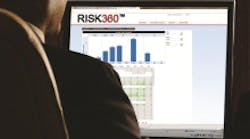3 keys to overcoming security labor shortages
With nationwide hiring challenges for security personnel continuing across companies, some are increasing pay or offering extra benefits to combat the problem, while others are investing in technologies that complement or reduce the need for trained professionals.
Added compensation and digital tools create a competitive edge; however, it is the careful alignment of people and processes that ultimately benefits job satisfaction and in turn, attracts and retains the talent that will continue to elevate the security operation.
Moving ahead, it is important to put technology at the center of everything without losing focus on the people it benefits most. Today’s security technologies are improving operations while simultaneously elevating the workforce by making it easier to perform one’s duties and enjoy a positive work experience.
Digital tools and data analytics are here to stay but, increasingly, security guards are choosing to leave the field due to better wages and perceived opportunities elsewhere. The remedy is an efficient security operation built on talent and stability that pairs the best people with the right technologies.The following are three critical considerations for any organization seeking to improve security by empowering individuals:
1. Focus on the Experience
While competitive wages must be part of any talent acquisition strategy, creating a sustainable workforce demands much more. What earns the loyalty of security guards? A focus on their experience.
For guards that spend long hours in the field, convenient access to company news, personnel updates, career-related resources and culture initiatives helps to create a link with their organization that goes beyond daily routines. Guards are better able to know and form bonds with the people they protect, which increases the likelihood of long-term job engagement. Also, remember that security guards can serve as great customer service ambassadors—the more authentic the connection to the organization, the higher the level of care tends to be.
There are many staff management and remote work tools worth exploring, each with the expectation that everything will be easily accessible and available on demand for security guards to discover at their convenience.
On the back end, apps and other digital resources can be deployed to enable field teams to access everything in one centralized location, including scheduling, time off requests, ordering of supplies, and payroll and benefits information. These same tools can give companies a wider view of security trends and staff deployment needs by keeping everyone better connected and in regular communication, helping to ensure that the right-size team is always in the right place. Tasks such as shift assignment, manually performing guard tours or confirming that a site is secure can all be automated with the right resources.
Security guards are bringing new perspectives and expectations to the job following the global pandemic that has ushered in a work-from-anywhere reality for millions of people. For security personnel who must report to the facility or property they protect, making that destination the desired one improves the work experience translating to increased job satisfaction, reduced turnover and enhanced team relationships and collaboration.
2. Elevate Talent with Technology
Technology can also create better-performing employees while improving job satisfaction. As the next generation of tech-savvy security professionals enters the workforce, organizations that do not provide the tools that make the job easier, safer and more efficient risk losing their talent to companies that do.
Intelligently integrating technology with the workforce can provide innovative, cost-efficient security packages that help prevent incidents, optimize security officers’ time and performance, and reduce operational costs.
There is a robust and growing array of actionable security technologies for companies to take advantage of including:
- Wireless surveillance cameras using facial recognition. These recorders don’t just identify faces, they also generate important insights about who is entering and exiting, and when—features that make investigating potential conflicts easier.
- Frictionless access control. These systems permit access to a secure area without requiring the user to present credentials to a reader. A well-designed system will allow people to go about their day freely while still providing peace of mind, which also frees up security personnel to focus on other tasks by eliminating manned points of entry.
- Remote reception visitor management systems. These can provide traditional reception services with the flexibility of not needing an on-site worker present. A self-service kiosk allows multiple visitor lobbies to be managed through live video feeds overseen by remote security officers.
- Smart sensors. Including infrared (IR), photoelectric beam, tomographic motion technologies and more, there are many types of sensors for expanding commercial security networks to detect events or changes in the environment reliably. Adding virtual eyes and ears to the patrol enables guards to focus on anomalies, rather than drowning in the minutia of a fleet of cameras.
Tech-enabled capabilities can serve as a force multiplier for on-site guarding and provide work-model options for security talent. While the technologies enabling these scenarios aren’t new, the level of connectivity we can now achieve is. The emergence of 5G broadband, with its improved reliability and ultra-HD streaming quality allows us to both imagine these scenarios and execute them more effectively and consistently.
Tools that eliminate repetitive tasks and provide timely data for personnel to make sound decisions enhance and simplify the job of a security guard that is rapidly changing due to technological innovation. Keeping guards, people and property safer also makes acquiring new talent easier.
3. Don’t Lose the Human Touch
Let’s not forget that while technologies can improve employee productivity and the performance of the security operation, the human element remains indispensable to thorough, adaptable guarding strategies.
Digitalization invites predictability, adds control and eliminates variables, but alone, the information harvested from security devices, sensors and systems is just data. Coupling it with talent that extrapolates key points, recognizes trends and makes educated decisions is critical to transforming data into insights and outcomes.
Empowered, experienced security talent can take data to the next level to create new operational efficiencies from staffing and scheduling to threat identification and incident response to close analysis of security trends and vulnerabilities. A clear understanding of security goals helps ensure the right technologies are deployed to deliver the optimal mix of prevention, deterrence, data and protection of assets.
Only security guards have the physical and decision-making abilities to consistently handle deviations from “business as usual” during their patrols. Technology can make this job more strategic and even perform high-risk tasks, however, people will always be the best defense against the unexpected.
Transforming the Industry
With security personnel in short supply, it is a blend of digital, connected tools supporting on-site, remote and mobile guarding services that can provide organizations with new options for staffing and more incentive for jobseekers—options that can help overcome labor challenges while creating positive experiences for employees.
By merging talent with technology, organizations can elevate both their security program and personnel simultaneously. Technology also plays a role in drawing professionals to the field and, once there, deepening their commitment to the organization, its associates and its mission. In this way, technology can make the world safer while infusing the security industry with sufficient new talent.







